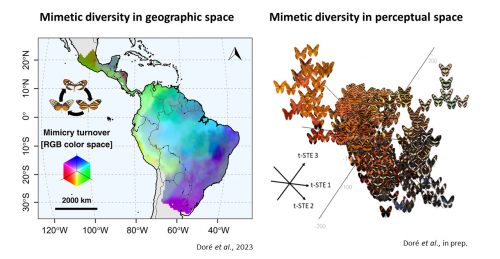
- This event has passed.
Beyond Müller’s mimicry model: perceptual maps support continental-scale convergence in wing patterns of sympatric Neotropical butterflies
Presented by: Maël Doré, Museum für Naturkunde – Leibniz Institute for Research on Evolution and Biodiversity, Berlin, Germany
Abstract: In 1879, Fritz Müller formulated the first mathematical evolutionary model to explain the local convergence of warning signals in toxic butterflies found in Neotropical rainforests. Yet, to which extent the distribution of unpalatable species at continental scale is driven by mimetic interactions remains to be quantified. Furthermore, to tackle this question in an evolutionary perspective, the degree of similarity in the warning signals harbored by species in sympatry must account for the perception by predators of such patterns.
I will present our results on the distribution of taxonomic, phylogenetic, and mimetic diversity of two flagship tribes of Neotropical butterflies, the Ithomiini (Nymphalidae: Danainae) and Heliconiini (Nymphalidae: Heliconiinae). In particular, I will address how we designed a Citizen Science project to describe perceived phenotypic variation in mimicry patterns, and tested for the unfolding to large spatial scales of Müller’s prediction for trait convergence between unpalatable species in sympatry.
Keywords: biodiversity maps, Citizen Science, climatic niche, evolutionary convergence, machine learning, Müllerian mimicry, Neotropical butterflies, perceptual maps, species distribution models.

Watch previously recorded webinars here
Thomas C. Emmel Seminar Series presents: Expanding Horizons in Lepidoptera Research
Continuing from Fall 2020, the McGuire Center is hosting this webinar series as an opportunity for both early career researchers as well as established leaders in the field to present their work. We hope that you will join us to hear about current advances in many diverse fields of Lepidoptera research.